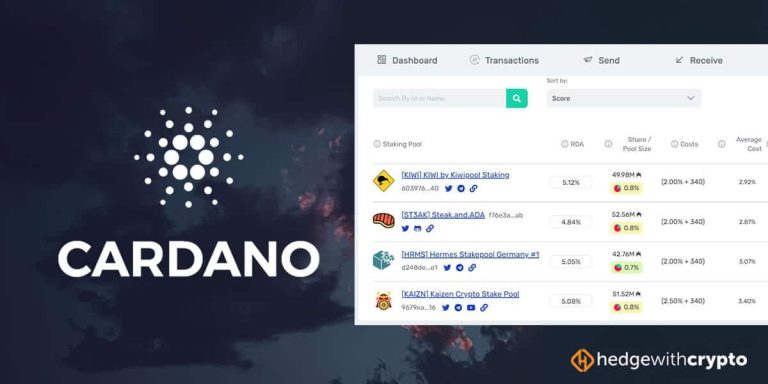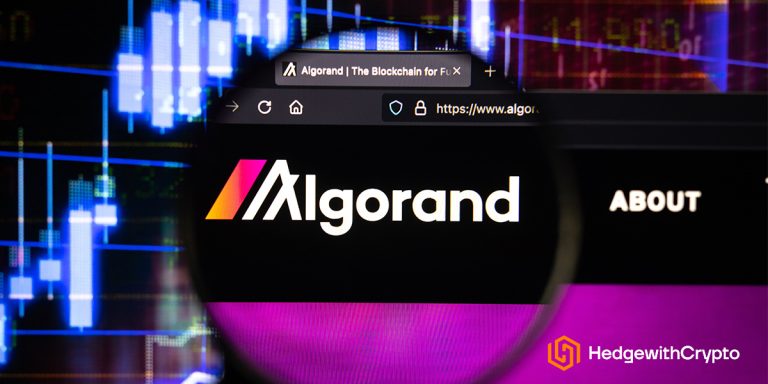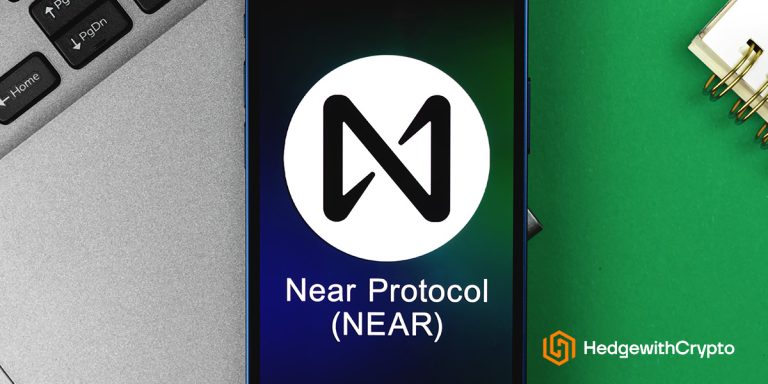We may earn a commission from links on our site, but this doesn’t affect our reviews. Learn more.
Hedge With Crypto is an independent publisher that provides objective and free content. Articles on our site may include links to our partners. If you click on these links, we may earn a commission. However, our editorial content remains unbiased, reflecting our own opinions or the general information available. For more information on our company policies, read the Affiliate Disclosure, Privacy Policy, and Terms & Conditions.
Where To Stake Solana
Hedge With Crypto aims to publish information that is factual and accurate as of the date of publication. For specific information about a cryptocurrency exchange or trading platform please visit that provider’s website. This information is general in nature and is for education purposes only. Hedge With Crypto does not provide financial advice nor does it take into account your personal financial situation. We encourage you to seek financial advice from an independent financial advisor where appropriate and make your own enquiries.
TABLE OF CONTENTS
Here's quick short list of where you can start staking Solana:
- Binance (best overall for staking)
- Kraken (good for flexible staking)
- Coinbase (best for beginners)
- Crypto.com (best for ease of use)
- Huobi (best for transparency)
- Phantom (good wallet for beginners)
- Solflare (best wallet for mobile app)
Centralized cryptocurrency exchanges that offer to stake are best suited for beginners as there is a lower barrier to entry in terms of knowledge and expertise. These platforms are simple to use and remove the need to find a suitable validator. For experienced investors who prefer to maintain custody of their SOL tokens, Solana wallets such as Solflare or Phantom can be used.
Where To Stake Solana To Earn Rewards
Cryptocurrency wallets and exchanges with soft staking are the best ways to stake crypto by delegating their Solana coins to earn a passive income. To find out how to stake crypto using these platforms, read this article.
The following table is a comparison of the top exchanges that support SOL staking. While the information is accurate at the time of writing, the staking reward is subject to change depending on the provider, validators and network.
| PLATFORM | NUMBER OF COINS | STAKING FEE | RATING | PROMOTION | WEBSITE | REVIEW |
|---|---|---|---|---|---|---|
|
|
None |
None |
Rating
We provide an overall weighted average rating out of 5 stars. Our ratings are based on objective criteria like the ease of use, fees, deposit methods, customer support and availability. Our reviews are not influenced by 3rd parties. Click here for further information about our rating methodology and a full list of categories we review against. 4.8 / 5 |
Up to $100 welcome bonus |
Visit Binance | Binance Review |
|
|
None |
None |
Rating
We provide an overall weighted average rating out of 5 stars. Our ratings are based on objective criteria like the ease of use, fees, deposit methods, customer support and availability. Our reviews are not influenced by 3rd parties. Click here for further information about our rating methodology and a full list of categories we review against. 4.8 / 5 |
None available at this time |
Visit Kraken | Kraken Review |
|
|
None |
25% |
Rating
We provide an overall weighted average rating out of 5 stars. Our ratings are based on objective criteria like the ease of use, fees, deposit methods, customer support and availability. Our reviews are not influenced by 3rd parties. Click here for further information about our rating methodology and a full list of categories we review against. 4.7 / 5 |
$5 BTC bonus (USA only) |
Visit Coinbase | Coinbase Review |
 Huobi Huobi
|
None |
None |
Rating
We provide an overall weighted average rating out of 5 stars. Our ratings are based on objective criteria like the ease of use, fees, deposit methods, customer support and availability. Our reviews are not influenced by 3rd parties. Click here for further information about our rating methodology and a full list of categories we review against. 4.2 / 5 |
None available at this time |
Visit Huobi | Huobi Review |
|
|
None |
None |
Rating
We provide an overall weighted average rating out of 5 stars. Our ratings are based on objective criteria like the ease of use, fees, deposit methods, customer support and availability. Our reviews are not influenced by 3rd parties. Click here for further information about our rating methodology and a full list of categories we review against. 4.5 / 5 |
$10 when stake > 1000 CRO tokens |
Visit Crypto.com… | Crypto.com Excha… |
Top Exchanges For Solana Staking
1. Binance
Binance is by far the most popular crypto exchange in the world, with its daily volume regularly dwarfing its competitors by eightfold. Much of its success is due to its glut of services – including unique earning opportunities, an NFT marketplace, and the ability to trade derivatives.
Binance is one of the best places to buy Solana and introduced SOL staking in February 2021, with an initial rewards rate of 43.79% APY. This extraordinarily high rate slowly dipped as staking became more popular, however, Binance still offers SOL owners competitive rates and a low barrier for entry that is suitable for all types of investors.

Binance users can lock up their SOL for either 30, 60 or 90 day periods. The longer the lock-up duration, the greater the estimated yield. The estimated staking rewards for the fixed durations are 9.28%, 10.23% and 13.47% APY respectively, which makes the platform one of the best platforms out there for staking SOL.
Binance calculates its interest daily, however, users who unlock their staked tokens prior to the redemption rate will lose access to any accrued rewards. The huge range of features offered by Binance, in conjunction with its ease of accessibility and high APY means it's our pick for the best SOL staking platform. However, investors in the USA should be aware that Binance.US does not currently support Solana staking and will need to use another provider. For a list of coins that can be staked, visit the Binance.US website.
2. Kraken
Kraken is an advanced trading platform that is a popular exchange for crypto investors and traders. While the user interface is dated, it is a reliable and secure exchange for buying, trading, staking and selling crypto. Kraken added international support for staking Solana in July 2021, with an initial APY of 6.5% on offer. An advantage of Kraken staking is the simple process of earning rewards on SOL tokens. Once Solana has been transferred or purchased, the wallet can be activated by navigating to the “Earn” section of the platform, selecting “Staking” and inputting the amount of SOL to stake.
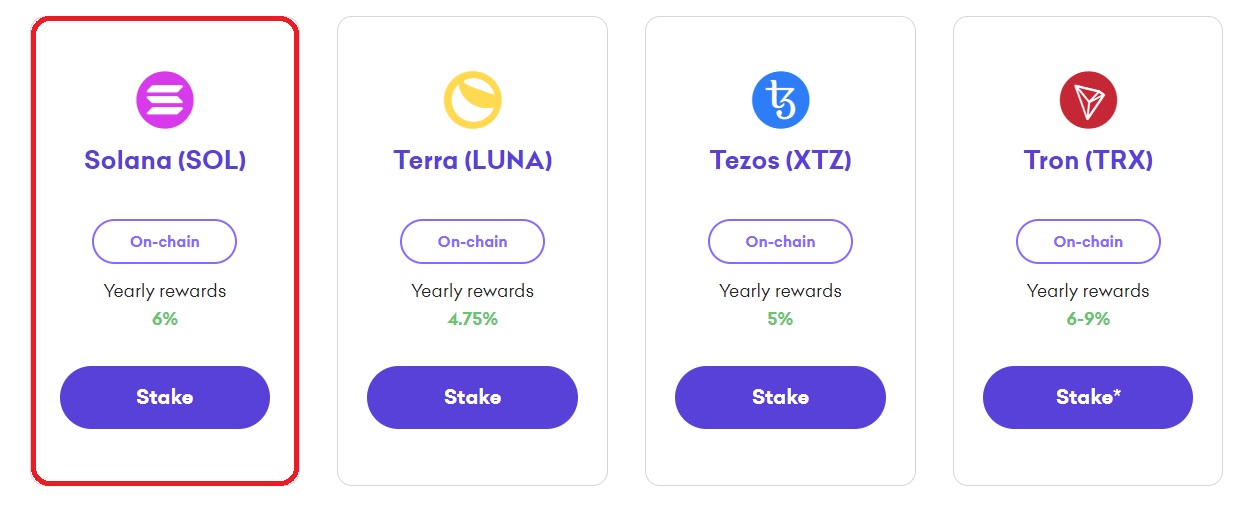
The current on-chain staking reward of 6% to 6.5% APY is similar compared to other exchanges such as Binance. However, the advantage of SOL staking on Kraken is the flexible staking terms. Other platforms require a locking period where the coins are locked in and can't be used for trading or withdrawn without a penalty.
Kraken's flexible staking means users who deposit at least 0.2 SOL into the staking contract can earn rewards and withdraw the tokens at any time. This makes Kraken a great option for cryptocurrency traders who want to earn rewards on Solana while waiting for a trading opportunity. However, due to litigation issues with the SEC, users in the USA cannot stake Solana on Kraken.
3. Coinbase
Coinbase introduced Solana staking to its list of assets in June 2022 that can be deposited to its staking wallet to earn rewards. As the offering of staking coins was quite limited previously, Coinbase Solana staking is a great addition that removes the need for setting up a staking service and becoming a validator.

Individuals who stake Solana tokens with Coinbase will automatically accrue SOL token rewards every 3 to 4 days. The current APY for Solana staking on Coinbase is around 3.85%, which is subject to change depending on market conditions. The minimum amount to begin staking SOL in a Coinbase wallet starts from just $1 which is a low barrier of entry for beginners. Moreover, the funds can be removed from the staking process at any time and not locked in.
The benefit of staking Solana with Coinbase is the ease of use. As the exchange features a beginner-friendly user experience, there is no requirement for advanced technical expertise or knowledge of staking. There is also peace of mind the Solana investment is safe due to the platform's excellent security measures. The only downside is the staking fees of 25% as stated in the Terms and Conditions.
4. Crypto.com Exchange
Crypto.com has quickly risen to become one of the most prominent apps in the crypto industry. From purchasing the naming rights to the Los Angeles stadium to partnering with sports club Paris Saint-Germain, Crypto.com has soared in stature over the past few years. While the platform initially operated as a basic cryptocurrency app, it has routinely been adding new financial services. NFT marketplaces, crypto debit cards and a robust exchange that offers coin staking.
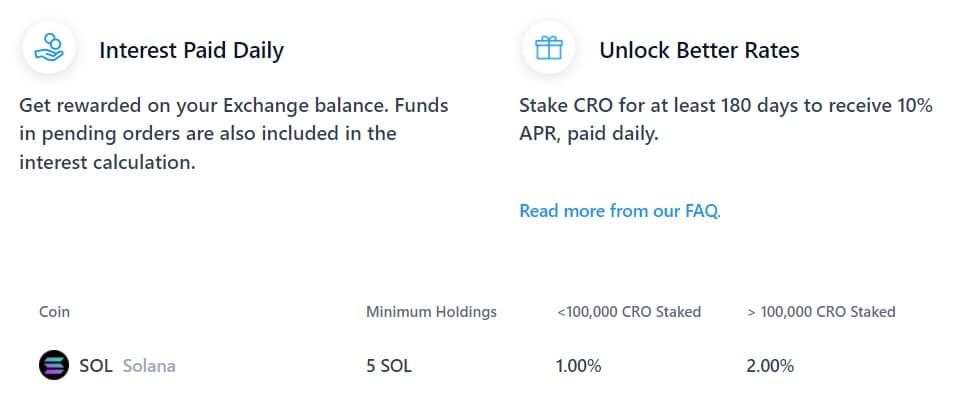
The benefit of staking Solana on Crypto.com Exchange is the ease of use. Once the soft-staking feature is enabled, assets within the wallet will automatically begin earning staking rewards. SOL rewards are paid out daily inclusive of Solana tokens used for pending orders on the exchange that have not been filled. There is a maximum limit on the amount of Solana that can be staked to earn rewards which is USD 10,000 or USD 100,000 equivalent in token balance.
Staking Solana on Crypto.com Exchange provides a reward of 1% APY or 2% which depends on whether the user is also staking CRO tokens. The higher SOL reward can be unlocked if more than 100,000 CRO tokens are staked on the exchange. This equates to approximately USD 47,000 worth at current prices which is not feasible for new investors. In addition, the estimated reward is less than the on-chain rate at the time of writing. The other disadvantage is the minimum of 5 SOL to stake.
5. Huobi Global
Huobi Global is a long-running cryptocurrency exchange that was established in 2013. The exchange has exploded in popularity and has offices in the US, Japan, Hong Kong and offers services to a broad range of nations.
At first glance, Huobi’s APY for staking SOL is fairly modest which is approximately 3.5% APY. For example, a user who locks-up 100 SOL tokens would earn 0.0095 SOL each day subject to fluctuations in the staking rewards. A point of difference from other soft-staking exchanges is that Huobi provides a link to the validator node which can be inspected using Blockchain Explorer that provides full transparency of delegated tokens within the staking pool. There is also a 5-day un-staking period.
Huobi does have limited-time special offers where users can earn free SOL by participating in community activities. The platform also rolls out infrequent staking promotions via Huobi Earn. These opportunities sometimes go as high as 50% APY, which is an extremely compelling interest rate. While Huobi may not be the best first-choice for staking SOL, it is worth investors keeping an eye on their promotions to maximize potential SOL earnings.
What Is Solana?
Solana is an open-source blockchain network with smart contract capabilities that is best known for its fast transaction speeds and broad range of NFT marketplaces and DeFi solutions. The blockchain uses Proof-of-Stake and Proof-of-history to execute smart contracts on the network. Validators are rewarded for via an annual percentage yield (APY) which operates exactly like an interest rate. Validators and participants who stake SOL tokens are rewarded.
Can You Stake Solana?
SOL holders can participate in the staking system by contributing their tokens to a node – either by running the server themselves or “delegating” their investment to someone else’s pool. By doing this, they are directly contributing to the economic security of the network and will receive a variable reward rate.
Solana has a very competitive staking reward and active ecosystem and is one of the best options for earning money via staking. In short, Solana is one of the best cryptos to stake based on the total amount locked in which is estimated at 44 billion at the time of writing. Due to the popularity of staking SOL tokens, Solana’s variable reward rate can be lower than its competitors. Other PoS staking protocols such as Cardano and Ethereum may provide a better yield than Solana.
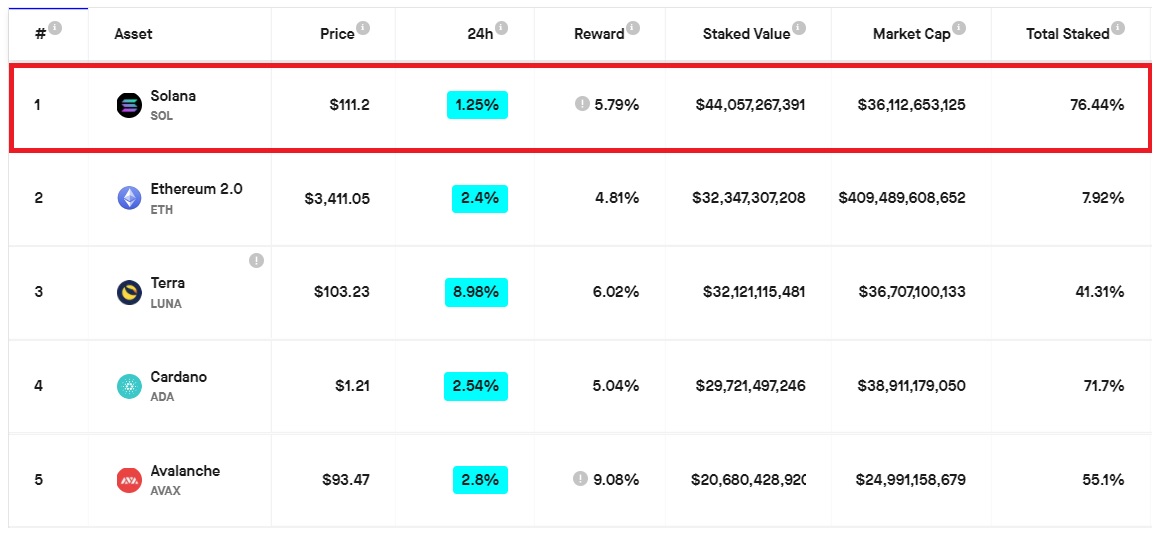
How Much Can You Earn Staking Solana?
Solana owners that stake their tokens will receive a reward that depends on the method of staking, which platform or exchange is used and how many SOL tokens are staked. The Annual Percentage Yield (APY) for staking Solana can range between 5–7%, although some platforms can offer higher or lower rates. Other factors that can affect the interest rate for staked tokens are:
- How many others are already staking on the network
- The commission rate (fee) is set by validators. This can range from 0%-10%+.
- The current inflation rate for SOL
As an example, if an investor locks up 10,000 SOL at a 6% APY rate, they could potentially earn 600 SOL at the end of the year. The staking reward rate on wallets and exchanges are estimates only and subject to change frequently.
How Does Staking Solana Work?
Proof-of-stake blockchain networks utilize a validator system to execute transactions – a more sustainable, environmentally-friendly mechanism compared to legacy proof-of-work (mining) methods. Essentially, “validators” – users who have locked up a portion of their Solana tokens in the network – run a “node” (server) that will be randomly selected to execute transactions on Solana.
Solana’s protocol combines this concept with something called “proof-of-history”. In simple terms, this timestamping mechanism pre-determines the order in which transactions will be validated, which in turn drastically improves efficiency. To learn more about Proof-of-Stake and how it works, read this article next.
How To Stake Solana
There are several different ways to stake your SOL, each with varying levels of complexity. The simplest way is using a crypto exchange which is easy to use and does not require any technical understanding of validators and wallets.
To stake SOL tokens using an exchange, follow these steps:
- Register an account with an exchange such as Binance
- Purchase, transfer or swap SOL tokens to a Binance wallet
- Select Solana (SOL) from the staking list
- Choose a lock-up duration and enter the amount of SOL to stake
- Confirm the transaction (by clicking “Stake Now”)
- Wait until the lock-up period is complete to withdraw funds
Solana Staking Using A Wallet
Staking Solana tokens with a wallet is a little more complex than via an exchange. It is up to the individual to find and choose a validator to delegate the SOL tokens into the pool. Due diligence is required on the validator to minimize staking risks. Three key statistics that should be assessed include:
- Uptime – validators with a low uptime are at risk of being slashed and removed from the network. Therefore, look for validators with as close to 100% uptime as possible.
- Number of participants – validators with a large number of delegators attached are likely to be safer than smaller alternatives. On the flipside, dedicating SOL to an independent delegator may have a greater rewards rate and lead to improving the overall decentralization of the Solana blockchain.
- Commission – this is the fee rate that validators will charge on any rewards earned.
The advantage of staking on a wallet is custody. Self-custodial wallets mean that even when the tokens are locked into the Solana network, the owners are still in complete control of their assets. This means the Solana investor is far less likely to be exposed to exchange hacks or malicious activities which can occur on centralized exchanges.
In short, the best wallets for staking SOL tokens are Phantom and Solflare.
Staking Solana Using Phantom Wallet
Phantom Wallet is a user-friendly digital wallet used to store, buy, send, receive, swap SOL tokens within the Solana ecosystem. The wallet can be acquired as an extension for the most popular web browsers – Chrome, Edge, Firefox and Brave. It also comes with a mobile application, though this is limited to iOS users. Moreover, the wallet is compatible with some of the best hardware wallets such as the Ledger Nano X to enhance the security of the private key.
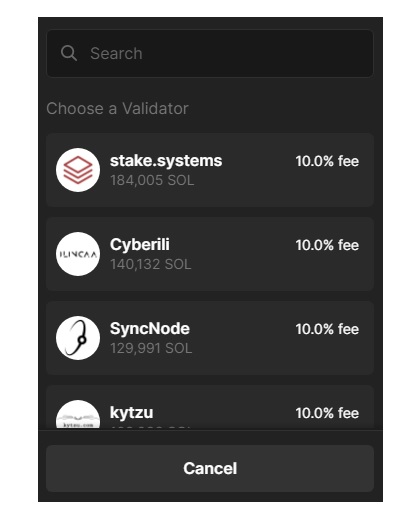
The wallet application provides a list of the available validators with their staking fee. The validators are listed based on popularity. It’s recommended to use an alternative list with more detail to pre-select the desired validator, as Phantom’s web wallet does not let individuals adjust the order based on factors such as uptime or commission.
The rewards rate for staking Solana on Phantom Wallet depends on the commission charged by validators (usually 10%) including other factors such as the number of participants in the pool. The estimated APY is between 5–7% using a Phantom wallet with the staking rewards issued once every ‘epoch’, which is approximately every 2 days on the Solana blockchain.
Staking Solana Using Solflare Wallet
Solflare is a wallet designed for the Solana network that was created by blockchain developer VGNG in partnership with Solana Labs. Solflare is one of the most prominent wallets available for SOL users. At the time of writing, approximately 24% of all circulating tokens are being staked on the platform.
Solflare is very similar to the Phantom wallet and has similar features such as in-app staking, NFT storage, transacting cryptocurrencies and integration with cold wallets like Ledger. There are a few advantages over the Phantom wallet which includes support for more platforms and the mobile application works on both Android and iOS devices, and the web extension functions on most browsers.
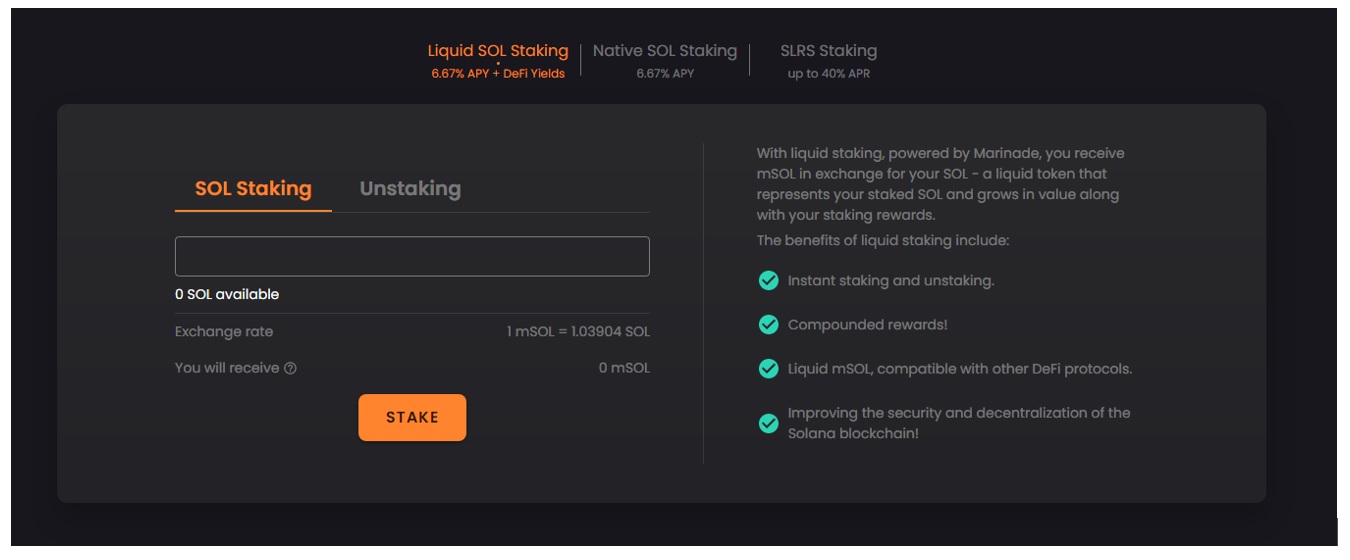
Moreover, Solflare prevents users from delegating their entire SOL balance to a validator. As each transaction on the network will require a small amount of SOL to be paid as a gas fee, this means owners need to keep SOL idle in the wallet to un-stake the tokens.
Another useful feature is liquid staking which allows individuals to receive a liquidity token (mSOL) in exchange for the SOL staked. This removes the opportunity cost of locking up SOL with a validator and gives the flexibility to delegate mSOL to other earning methods such as liquidity pools. The Solflare wallet is a great option for slightly more advanced crypto users with estimated rewards between 6–7% APY.
Are There Any Risks With Solana Staking?
Solana is one of the best networks to passively earn on an investment, however, this doesn’t mean it comes without risks. Stakers have to watch out for slashing which occurs when a validator running a node acts maliciously or doesn’t meet the uptime requirements for the network. This results in the validator losing a proportion of their rewards, or sometimes, all of them. If the SOL is delegated to a validator who is slashed, the owner may end up losing some of their investment.
Frequently Asked Questions
What Is The Minimum Amount To Stake Solana?
Cryptocurrency trading platforms such as Kraken offer soft-staking of Solana tokens from as little as 0.00000001 SOL. The minimum staking amount on other exchanges such as Binance and Huobi are 0.0001 SOL and 0.1 SOL respectively.
Is Staking Solana Profitable?
Solana is a popular cryptocurrency that has been in an uptrend since December 2020 which saw the price climb 24,275% against US Dollars at its peak in November 2021. During the year, the staking reward for SOL tokens were as high as 50% APY. The staking reward for Solana is approximately 6% APY which is an attractive yield for many investors that can help offset price volatility.
Can You Stake Solana On Coinbase?
Coinbase added support Solana (SOL) staking on the exchange in June 2022. Users can stake SOL tokens and earn up to 3.85% APY at the time of writing. Staked Solana tokens within a Coinbase wallet will accrue rewards automatically.
